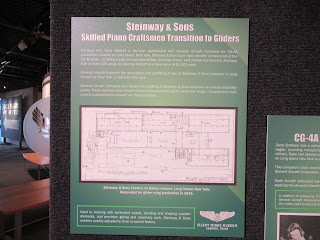The Liberty Gazette
November 7, 2023
Ely Air Lines
By Mike Ely and Linda Street-Ely
You might have known that balloons have been used in military operations since the earliest days of flight, but did you know gliders have been enlisted as well? The non-motorized aircraft are quiet, so they could sneak in behind enemy lines without being heard. If they came in at night, which they frequently did, all the better, as they often landed undetected. They brought in men, weapons, food, and other supplies, and even vehicles.
Since our annual birthday hike in Palo Duro Canyon was shortened to just one day due to inclement weather, we took a trip down to Lubbock for indoor activities. The Silent Wings Museum honors veterans who flew gliders during WWII and is dedicated to the memory of all who received advanced glider training and earned Silver ‘G’ Wings at this airfield. While the ‘G’ was officially for Glider, it was said that it really stood for Guts, because these men were flying a one-way trip. There was no turning around. They flew fragile, unarmed gliders on eight major airborne invasions of Europe and Southeast Asia, including Market Garden (invasion of The Netherlands), Varsity (invasion of Germany), and Overlord (the D-Day allied invasion of Normandy, France). Many paid the supreme sacrifice for their country.
The museum also does a tremendous job of educating the public on these heroes and this facet of war.
There were nine preliminary and advanced military glider pilot training fields in Texas. The one in Lubbock was one of the most prominent, The U.S. Army Air Force leased the airport from the city, and from October 1942 to April 1, 1945. This was where about 80% of the combat glider pilots who served in the major operations were trained to fly the 15-man Waco CG-4A glider.
Did you know that Steinway and Sons piano craftsmen in Long Island, New York built many of the wooden components for the Waco CG-4A glider, including wings and tail assemblies, benches, floors, and cockpit frameworks? It was a time when our country was more cohesive, and the infiltration of commies hadn’t exploded to the level it is today. Businesses and individuals proudly sacrificed to do what was needed to help defend and preserve freedom.
A short documentary film with interviews of some of the pilots, fascinating artifacts, and impactful reenactment scene displays make this museum a must-see. They even have one of these huge CG-4A gliders on display in the hangar, and one of its tow planes, a DC-3, greeting visitors at the entrance.
We were surprised, however, to see how long ago air combat was discussed. Here’s a quote from lexicographer Dr. Samuel Johnson, whose house we happened to visit while in London this summer: “What would be the security of the good, if the bad could at pleasure invade them from the sky? Against an army sailing through the clouds, neither walls, nor mountains, nor seas, could afford any security.” Dr. Johnson realized the possibilities of aerial attacks in 1759.
ElyAirLines.blogspot.com





No comments:
Post a Comment